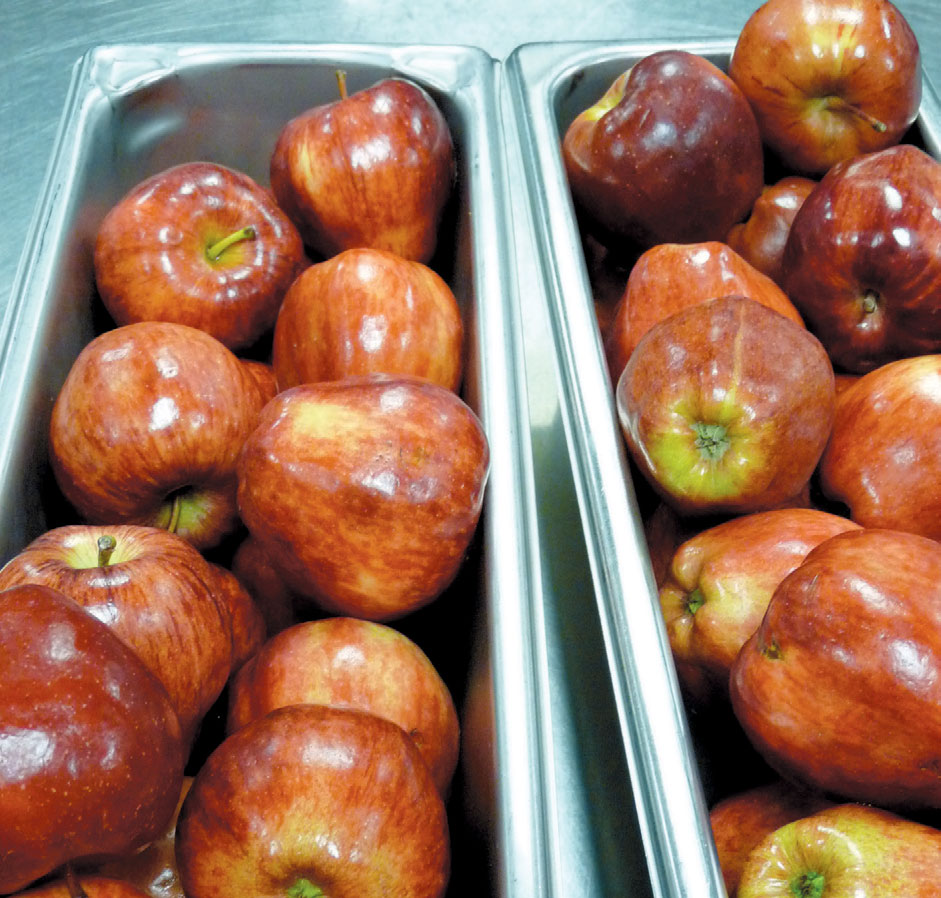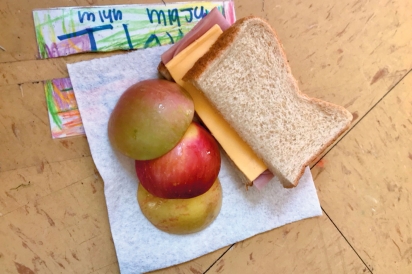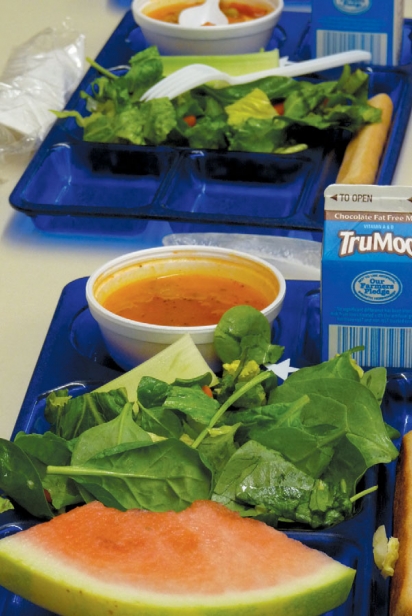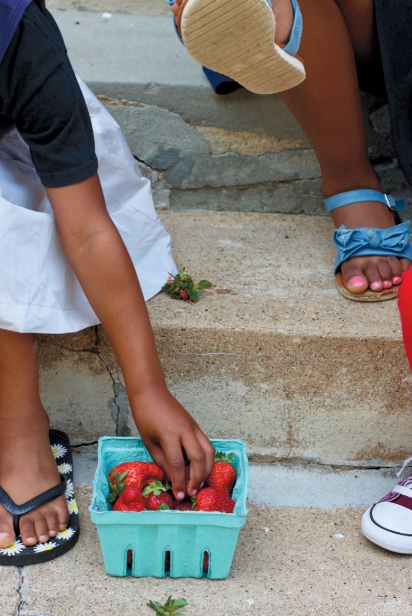Hungry in Summer: Providing Kids with Year-Round Access to Nutritious Meals
For many kids summer means a break from school (and the meals provided there) but not a break from hunger. Find out what Upstate organizations are doing to feed our youngest citizens all summer long.
For twelve years Jenny Reeves, along with husband Matt, has directed afterschool programs for low-income students at The Frazee Center in Greenville’s historic Hampton-Pinckney District. During those months when school is in session, they provide snacks, activities, and supper each evening. “What you notice at the start of summer, though,” she says, “is that first day the bus doesn’t come, well, there goes breakfast and lunch for a lot of kids.”
Jenny and Matt opened a camp for the warmer months available to children (and their siblings) who already participate in Frazee during the year. They founded the center with roughly ten youth, and now that number has grown to include 110-130 children while school is in session and upwards of 100 in the summer. “By including in our summer camp students we already have relationships with, we’re able to better manage staff, kids, volunteers, and opportunities.”
One quadrant where the Reeves carry an abundance of opportunity is in their relationships with vendors. Every Monday, Loaves and Fishes arrives in a refrigerated truck to drop off everything from produce to protein. With that consistent donation alone, Matt Reeves has said, “we can feed 85 children for 22 cents each.” The Frazee Center also receives help from House of Raeford Farms Chaplain Curtis Carr, who donates chicken, along with the folks at Hunters for the Hungry Spartanburg, who provide everything from hog to deer meat.
Along with after school and summer programs, Frazee houses a preschool, middle school, and mentoring program that strives to connect middle class and low-income citizens. The center is also preparing transition, due to a shift in need, into a new location several miles outside of downtown. “Back when we first started, most of our kids could walk here from home or school,” Jenny says. “Now that number’s decreased to maybe six or eight.” The new spot will be more convenient for more students. “Over the years we’ve evolved and changed what we do,” she adds. “But the single thing we’ve been consistent with is feeding kids—that one’s a no brainer.”
Food insecurity is defined as a state of being without reliable access to a sufficient quantity of affordable, nutritious food. Relative to other areas in South Carolina, the Upstate’s percentage of food-insecure youth is low, and that average (between Anderson, Greenville, Pickens, and Spartanburg) still hovers around 20%, nearly 50,000 children. Our community continues to foster an increasing variety of summer feeding strategies to better serve more students.
The USDA funds two different types of programs that feed students who, during the school year, receive free and reduced meals. Summer Food Service Programs (SFSP) reimburse sponsors of enrichment, recreational, and activity programs for free meals served to children, including teenagers through the age of eighteen, at approved meal sites in low-income areas. Local non-profit organizations, school districts, and the government agree with the South Carolina Department of Education to sponsor the SFSP and provide meals that meet USDA guidelines. The Seamless Summer Option (SSO) is geared toward schools that currently already participate in National School Lunch (NSLP) or Breakfast Programs (SBP). This program allows schools to continue the meal trajectory already in place throughout the year.
Under the umbrella of the aforementioned, programs fall into either “open” or “enrolled” (aka “closed”) sites. Open sites are situated in low-income areas where at least 50% of students are eligible for free or reduced meals; these sites welcome all children from the community aged eighteen and under. Closed sites, such as camps, are open only to students enrolled in said program. These sites qualify if they are located in a low-income area.
SFSP was first authorized by the USDA to instate residential summer camps and sites in 1975. Just two years later in 1977, 23,700 sites had opened nationwide. Statewide, 2,000 sites were approved in 2017 and, at any given point , 1,500-1,700 of those were in operation. The target projection for 2018 is to increase overall number of sites by 5%. In the summer of 2015, Greenville carried only fifteen feeding sites. Director of Greenville County Schools Joe Urban says, “Summer feeding plans are still a work in progress, but as of today we’ll have about fifty summer program locations that will serve approximately 5,000 meals each day, including 15-20 school sites.”
That doesn’t include the dozen or so mobile feeding sites served from the truck. In July of 2016, Greenville County Schools Food and Nutrition Services (FANS) introduced a food truck into the repertoire of providing students meals. During the year it’s used to promote foodservice programs at field trips, school carnivals, and other community events, along with introducing new items to the breakfast and lunch menus. In warmer months, however, the truck assists in USDA’s summer programs by going into neighborhoods and apartment complexes. Mobility is obviously a critical element of accessibilities, and the truck is able to provide that. “This addition has added 500-700 meals per day to needy children who do not have access to one of our regular feeding locations.”
Anderson School District Five has also implemented a food truck named Café Express. Director of their Culinary Services Sharon Hunt says, “We’ve seen a slow but steady increase in summer feeding participation. The truck, an increase in social media resources, a long with a dedicated team of professionals willing to beat the heat to reach students, has made it easier than ever to add sites. Still, there are a few gaps. While several tools are available to assist in determining areas in need, t here remain small pockets of neighborhoods surrounded by more affluent areas often are left without access to this service.”
“Greenville does an outstanding job with summer feeding sites,” says Ron Jones, Director of Health and Nutrition for South Carolina’s Department of Education, “but there’s always room to grow. It’s not like hunger takes a break. You can’t nail down a root cause to a complex problem, and so there’s no easy fix. There’s a lot of pressure on the family dollar. Often you’re choosing between paying the electric bill and going to the grocery, and so programs like these allow people to spread their resources.”
Because of its complex nature, poverty is not simply an issue; it’s a system of issues. Along with food insecurity, the Upstate carries a high obesity rate—66% of adults in Greenville County, and 41% of youth. LiveWell Greenville opened in 2011 with the mission to champion increased access to healthier foods, along with more available sources for physical activity and policy change for the betterment of our community. Director Erica McCleskey says, “I think people are finally starting to understand that nutrition along with childhood obesity are problems, and Greenville is a community that wraps its arms around the issue and tries to connect resources.” As Jenny Reeves puts it: “Food is not the issue. We have plenty of food. It’s figuring out how to put it into hands that will prepare it, how to teach the skill sets of preparing it, how to make it available.”
LiveWell hosts a summer-long scavenger hunt called Park Hop that “encourages children and families to discover featured parks while searching for answers to clues in each of them.” Programs like these, along with the twenty-plus mile stretch of our GHS Swamp Rabbit Trail, offer free and available access to exercise in the out-of-school summer months. LiveWell also strives to link programs and vendors, as it’s done for example in the past by introducing Marvin’s Produce to after school feeding programs.
These local systems of communication drive increasing success, but while many teachers and families of students are aware of these programs, just as many didn’t seem to know of their existence. Aside from spreading information and education, the four main practical ways citizens can contribute are by sponsoring a site, running one, becoming a vendor, or volunteering. “We aren’t leaders,” says MCleskey. “We’re conveners. We serve as a neutral table that keeps the conversation going, that connects people, that drives action.”









